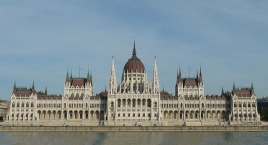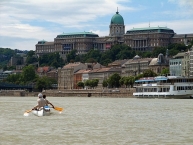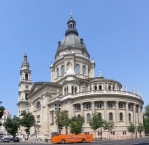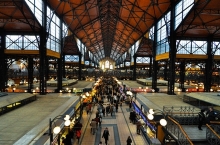Cycle Tour Arnaud & Nicolas Summer road (Euro6)
Planned tour
Actions
![]()
Please wait - map data are loading
Added on 18 Apr 2019,
last edited by Lasco on 19 Apr 2019
Actions
Cycle route metrics
planned
ridden
Total distance in km
1.395
0
Cumulative elevation gain in m
12.728
0
Avg. slope uphill in %
0,91
-
Cumulative elevation loss in m
12.593
0
Information about rights to the gps-track data | |
|---|---|
Rights owner | |
Rights characteristic / license | cc0: Public Domain no Rights reserved |
Link to the description of the license | |
GPX file uploaded | by Lasco on 19 Apr 2019
|
Track points in total
15.690
0
Track points per km (avg)
11
0
Start/endpoint
Start location
Budapest, HU (101 m NHN)
End location
Sausheim, Grand Est, FR (236 m NHN)
Beds4Cyclists, worth visiting and infrastructure
Name and address
Latitude / Longitude
Phone
Fax
Mobile
Type of accommodation
Rating for cyclists
Route km
Dist. to route
Elevation
0 km
3,0 km
111 m
0 km
3,1 km
110 m
0 km
2,7 km
103 m
Information about copyright | |
|---|---|
Rights owner | |
Rights characteristic / license | by-sa: CREATIVE COMMONS Attribution-ShareAlike |
Link to the description of the license | |
Image taken over from | https://commons.wikimedia.org/wiki/File:Parliament_Buildung_Hungary_20090920.jpg |
Image has been uploaded | by biroto-Redaktion on 03 Jan 2015
|
Information about copyright | |
|---|---|
Rights owner | |
Rights characteristic / license | by-sa: CREATIVE COMMONS Attribution-ShareAlike |
Link to the description of the license | |
Image taken over from | https://commons.wikimedia.org/wiki/File:Volt_Királyi_palota_(138._számú_műemlék)_36.jpg |
Image has been uploaded | by biroto-Redaktion on 03 Jan 2015
|
Information about copyright | |
|---|---|
Rights owner | |
Rights characteristic / license | by-sa: CREATIVE COMMONS Attribution-ShareAlike |
Link to the description of the license | |
Image taken over from | https://commons.wikimedia.org/wiki/File:Budapest_bazylika_sw_Stefana_01.jpg |
Image has been uploaded | by biroto-Redaktion on 03 Jan 2015
|
Information about copyright | |
|---|---|
Rights owner | https://commons.wikimedia.org/w/index.php?title=User:Dd-ang2s |
Rights characteristic / license | cc0: Public Domain no Rights reserved |
Link to the description of the license | |
Image taken over from | https://commons.wikimedia.org/wiki/File:Budapest_great_market_hall.jpg |
Image has been uploaded | by biroto-Redaktion on 03 Jan 2015
|
Budapest /ˈbuːdəpɛst/ (Hungarian: [ˈbudɒpɛʃt]) is the capital and the largest city of Hungary, and one of the largest cities in the European Union. It is the country's principal political, cultural, commercial, industrial, and transportation centre, sometimes described as the primate city of Hungary. In 2011, according to the census, Budapest had 1.74 million inhabitants, down from its 1989 peak of 2.1 million due to suburbanisation. The Budapest Metropolitan Area is home to 3.3 million people. The city covers an area of 525 square kilometres (202.7 sq mi) within the city limits. Budapest became a single city occupying both banks of the river Danube with its unification on 17 November 1873 of Buda and Óbuda
, on the west bank, with Pest
, on the east bank.
The history of Budapest began with Aquincum , originally a Celtic settlement that became the Roman capital of Pannonia Inferior.Hungarians arrived in the territory in the 9th century. Their first settlement was pillaged by the Mongols in 1241–42. The re-established town became one of the centres of Renaissance humanist culture in the 15th century. Following the Battle of Mohács and nearly 150 years of Ottoman rule, the region entered a new age of prosperity in the 18th and 19th centuries, and Budapest became a global city after its unification in 1873. It also became the second capital of the Austro-Hungarian Empire, a great power that dissolved in 1918, following World War I. Budapest was the focal point of the Hungarian Revolution of 1848, the Hungarian Republic of Councils of 1919, Operation Panzerfaust in 1944, the Battle of Budapest in 1945, and the Revolution of 1956.
Cited as one of the most beautiful cities in Europe, Budapest's extensive World Heritage Site includes the banks of the Danube , the Buda Castle Quarter, Andrássy Avenue
, Heroes' Square
and the Millennium Underground Railway
, the second-oldest metro line in the world. It has around 80 geothermal springs
, the world's largest thermal water cave system, second largest synagogue
, and third largest Parliament
building. The city attracts about 4.3 million tourists a year, the 25th most popular city in the world, and the 6th in Europe, according to Euromonitor.
Main sights and tourism
The neo-Gothic Parliament , the biggest building in Hungary with its 268 metres (879 ft) length, containing amongst other things the Hungarian Crown Jewels
. Saint Stephen's Basilica
, where the Holy Right Hand
of the founder of Hungary, King Saint Stephen is on display. The Hungarian cuisine and café culture: for example, Gerbeaud Café
, and the Százéves, Biarritz, Fortuna, Alabárdos, Arany Szarvas, Kárpátia and the world famous Mátyás Pince Restaurants. There are Roman remains
at the Aquincum Museum
, and historic furniture at the Nagytétény Castle Museum
, just 2 out of 223 museums in Budapest. Another historical museum is the House of Terror
, hosted in the building that was the venue of the Nazi Headquarters
. The Castle Hill
, the River Danube
embankments and the whole of Andrássy út
have been officially recognized as UNESCO World Heritage Sites.
Castle Hill and the Castle District ; there are three churches here, six museums, and a host of interesting buildings, streets and squares. The former Royal Palace
is one of the symbols of Hungary – and has been the scene of battles and wars ever since the 13th century. Nowadays it houses two impressive museums and the National Széchenyi Library
. The nearby Sándor Palace
contains the offices and official residence of the President of Hungary
. The seven-hundred year-old Matthias Church
is one of the jewels of Budapest, it is in neo-Gothic style, decorated with coloured shingles and elegant pinnacles. Next to it is an equestrian statue of the first king of Hungary, King Saint Stephen, and behind that is the Fisherman's Bastion
, built in 1905 by the architect Frigyes Schulek
, the Fishermen's Bastions owes its name to the namesake corporation that during the Middle Ages was responsible of the defence of this part of ramparts, from where opens out a panoramic view of the whole city. Statues of the Turul
, the mythical guardian bird of Hungary, can be found in both the Castle District and the Twelfth District
.
In Pest , arguably the most important sight is Andrássy út
. This Avenue is an elegant 2.5 km (2 mi) long tree-lined street that covers the distance from Deák Ferenc tér
to the Heroes Square
. On this Avenue overlook many important sites. It is a UNESCO World Heritage Site. As far as Kodály körönd
and Oktogon both sides are lined with large shops and flats built close together. Between there and Heroes' Square the houses are detached and altogether grander. Under the whole runs continental Europe's oldest Underground railway, most of whose stations retain their original appearance. Heroes' Square is dominated by the Millenary Monument
, with the Tomb of the Unknown Soldier
in front. To the sides are the Museum of Fine Arts
and the Kunsthalle Budapest
, and behind City Park
opens out, with Vajdahunyad Castle
. One of the jewels of Andrássy út is the Hungarian State Opera House
. Statue Park
, a theme park with striking statues of the Communist era, is located just outside the main city and is accessible by public transport.
The Dohány Street Synagogue is the largest synagogue
in Europe, and the second largest active synagogue in the world. The synagogue is located in the Jewish district
taking up several blocks in central Budapest bordered by Király utca, Wesselényi utca, Grand Boulevard
and Bajcsy Zsilinszky road. It was built in moorish revival style in 1859 and has a capacity of 3000 people. Adjacent to it is a sculpture reproducing a weeping willow tree in steel to commemorate the Hungarian victims of the Holocaust. The city is also home to the largest medicinal bath in Europe (Széchenyi Medicinal Bath
) and the third largest Parliament building
in the world
, once the largest in the world. Other attractions are the bridges of the capital
. Seven bridges provide crossings over the Danube, and from north to south are: the Árpád Bridge
(built in 1950 at the north of Margaret Island
); the Margaret Bridge
(built in 1901, destroyed during the war by an explosion and then rebuilt in 1948); the Chain Bridge
(built in 1849, destroyed during the II World War and the rebuilt in 1949); the Elisabeth Bridge
(completed in 1903 and dedicated to the murdered Queen Elisabeth, it was destroyed by the Germans during the war and rebuilt in 1964); the Liberty Bridge
(opened in 1896 and rebuilt in 1989 in Art Nouveau style); the Petőfi Bridge
(completed in 1937, destroyed during the war and rebuilt in 1952); the Rákóczi Bridge
(completed in 1995). Most remarkable for their beauty are the Margaret bridge, the Chain bridge and the Liberty bridge. The world's largest panorama photograph was created in (and of) Budapest in 2010.
Tourists visiting Budapest can receive free maps and information from the nonprofit Budapest Festival and Tourism Center at its info-points. The info centers also offer the Budapest Card which allows free public transit and discounts for several museums, restaurants and other places of interest. Cards are available for 24, 48 or 72-hour durations. The city is also well known for its ruin bars both day and night.
Information about copyright | |
|---|---|
Rights characteristic / license | by-sa: CREATIVE COMMONS Attribution-ShareAlike |
Link to the description of the license | |
Input taken over from: |
Wikipedia contributors, 'Budapest', Wikipedia, The Free Encyclopedia, 31 December 2014, 10:29 UTC, http://en.wikipedia.org/w/index.php?title=Budapest&oldid=640366090 |
taken over / edited on | 03 Jan 2015 - 07 Mar 2023
|
taken over / edited by |
|
0 km
2,2 km
Hours of opening
08:00 - 20:00 h every day
Languages spoken:
magyar nyelv
0 km
2,1 km
117 m
![]()




